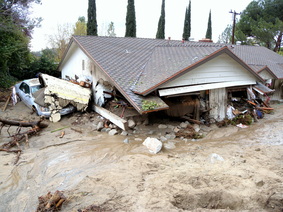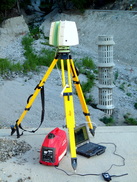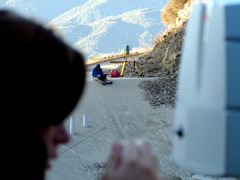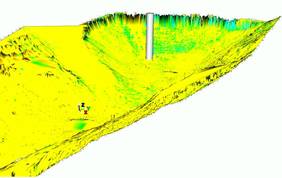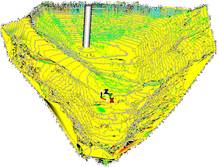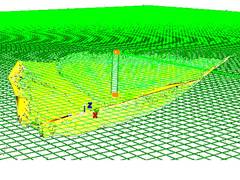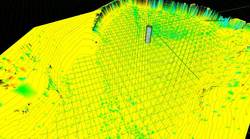Why Measure?
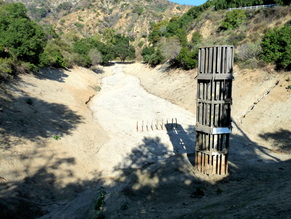
Debris Basin and Snorkel
The USGS (US Geologic Survey) provides debris flow inundation prediction for areas that are at risk for debris flows. This warns residents (similar to a flood warning) when and where debris flows are likely to occur and also provides them with maps of the areas that will be potentially inundated. The accuracy of the USGS predictions are crucial. Predicting the magnitude, location and time of debris flow events is still an inaccurate science, which leads to a majority false positive debris flow warnings. As a result of the false positive warnings, most people disregard the warnings by refusing to leave their home, making them susceptible to the hazard of a debris flow.
In addition to the debris flow warnings, debris basins (left) provide a level of physical protection from debris flows by capturing and storing the flows (water, sediment and boulders) before they reach developed areas. The debris basins also provide a way of measuring the amount of sediment that is transported from the burned areas, since they capture most of the debris flows which flow towards areas of development. Knowing the quantity of sediment in these debris basins allows researchers at the USGS a way of calibrating their debris flow prediction models, thereby increasing the models accuracy, reducing the occurrence of false positive warnings, and subsequently reduce the hazard of debris flows.
In November of 2010, I led a three person survey team to La Canada Flintridge, California where we scanned 12 debris basins over 2 1/2 days. Our surveys provided the USGS with a very accurate assessment of the storage capacity of 12 debris basins.
In addition to the debris flow warnings, debris basins (left) provide a level of physical protection from debris flows by capturing and storing the flows (water, sediment and boulders) before they reach developed areas. The debris basins also provide a way of measuring the amount of sediment that is transported from the burned areas, since they capture most of the debris flows which flow towards areas of development. Knowing the quantity of sediment in these debris basins allows researchers at the USGS a way of calibrating their debris flow prediction models, thereby increasing the models accuracy, reducing the occurrence of false positive warnings, and subsequently reduce the hazard of debris flows.
In November of 2010, I led a three person survey team to La Canada Flintridge, California where we scanned 12 debris basins over 2 1/2 days. Our surveys provided the USGS with a very accurate assessment of the storage capacity of 12 debris basins.
The scans from each of the debris basins were combined and registered within Cyclone 7.1. A reference plane was fit at the top of each debris basin snorkel, and since the volume of each debris basin cannot exceed the top of the snorkel, all points above the reference plane were deleted. Significant vegetation re-growth in most of the debris basins necessitated manual vegetation filtering using a limit box approach in Cyclone 7.1. A limit box allows temporary point cloud segmentation, reducing background noise, assisting with the removal of unwanted points (i.e. vegetation, targets, etc...). However, there is a high degree of probability that not all points
representing vegetation were removed using this process. Therefore,
volume measures should be considered as minima volumes as missed
vegetation points would decrease the overall volumes. A cylinder was fit to each debris basins snorkel. The cylinder serves as a perfectly vertical measuring tool, facilitating volume measurements at set intervals, beginning at the top of the snorkel and moving down.
Each debris basin, once filtered for vegetation, was meshed using an "up-direction" Triangulated Irregular Network (TIN) resulting in a Digital Terrain Model (DTM) for each debris basin. A reference plane was fit to the top of the modeled cylinder and volume measurements were made from the reference plane down to the DTM. On average 100 measurements were made per square meter to calculate the volume measurements. Once volume was calculated at a given height, the cylinder was moved down along the z axis, -0.333 meters (1 foot), the reference plane was moved to fit the top of the cylinder and another volume measurement was made. This was repeated until volume is zero.
_This work is based upon work supported by a Cooperative Agreement with
U.S. Geological Survey Landslide Hazards Program entitled "Close-Range
Photogrammetry and Terrestrial Laser Scanning Data and Analysis" - Thad
Wasklewicz, PI
